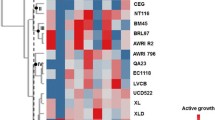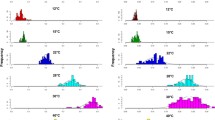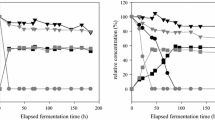Abstract
The loss of viability of wine yeast strains due to low-temperature fermentations could be overcome by increasing their stress tolerance and adaptability. Changes in membrane lipid composition are one of the first responses to cold stress. The aim of this study was to analyze the various adaptation mechanisms to low temperatures by comparing the better adapted Saccharomyces species. The viability, vitality, fermentation capacity, and lipid composition of different Saccharomyces species (S. cerevisiae, S. bayanus, S. uvarum, and a hybrid S. cerevisiae/S. uvarum) with different fermentative origins (wine, beer, and baker’s strains together with a laboratory strain) were compared after culturing at low (13 °C) and optimal (25 °C) temperatures. In spite of specific responses of the different strains/species, the results showed that at low temperature, the medium-chain fatty acid and the triacylglyceride content increased, whereas the phosphatidic acid content and the phosphatidylcholine/phosphatidylethanolamine ratio decreased. Only the laboratory strain was not able to ferment the sugars, and after growing at both temperatures, its lipid composition was very different from that of the other strains. The hybrid strain showed the highest sugar consumption at 13 °C and the best vitality whatever the preculture temperature used. The rest of the species needed a preadaptation at low temperature involving a change in their lipid composition to improve their fermentation rate at 13 °C.


Similar content being viewed by others
References
Beltran G, Novo M, Guillamón JM, Mas A, Rozès N (2008) Effect of fermentation temperature and culture media on the yeast lipid composition and wine volatile compounds. Int J Food Microbiol 121:169–177
Llauradó J, Rozès N, Bobet R, Mas A, Constantí M (2002) Low temperature alcoholic fermentation in high sugar concentration grape musts. J Food Sci 67:268–273
Torija MJ, Beltran G, Novo M, Poblet M, Guillamón JM, Mas A, Rozès N (2003) Effects of fermentation temperature and Saccharomyces species on the cell fatty acid composition and presence of volatile compounds in wine. Int J Food Microbiol 85:127–136
Beltran G, Novo M, Leberre V, Sokol S, Labourdette D, Guillamón JM, Mas A, François J, Rozès N (2006) Integration of transcriptomic and metabolic analyses for understanding the global responses of low-temperature winemaking fermentations. FEMS Yeast Res 6:1167–1183
Salvadó Z, Chiva R, Rodríguez-Vargas S, Rández-Gil F, Mas A, Guillamón JM (2008) Proteomic evolution of a wine yeast during the first hours of fermentation. FEMS Yeast Res 8:1137–1146
Sakamoto T, Murata N (2002) Regulation of the desaturation of fatty acids and its role in tolerance to cold and salt stress. Curr Opin Microbiol 5:208–210
Redón M, Guillamón JM, Mas A, Rozès N (2009) Effect of lipid supplementation upon Saccharomyces cerevisiae lipid composition and fermentation performance at low temperature. Eur Food Res Technol 228:833–840
Naumov GI, Masneuf I, Naumova ES, Aigle M, Dubourdieu D (2000) Association of Saccharomyces bayanus var. uvarum with some French wines: genetic analysis of yeast populations. Res Microbiol 151:683–691
Nguyen HV, Gaillardin C (2005) Evolutionary relationships between the former species Saccharomyces uvarum and the hybrids Saccharomyces bayanus and Saccharomyces pastorianus; reinstatement of Saccharomyces uvarum (Beijerinck) as a distinct species. FEMS Yeast Res 5:471–483
Pulvirenti A, Nguyen H, Caggia C, Giudici P, Rainieri S, Zambonelli C (2000) Saccharomyces uvarum, a proper species within Saccharomyces sensu stricto. FEMS Microbiol Lett 192:191–196
Naumov GI, Nguyen HV, Naumova ES, Michel A, Aigle M, Gaillardin C (2001) Genetic identification of Saccharomyces bayanus var. uvarum, a cider-fermenting yeast. Int J Food Microbiol 65:163–171
Naumov GI, Naumova ES, Antunovics Z, Sipiczki M (2002) Saccharomyces bayanus var. uvarum in Tokaj wine-making of Slovakia and Hungary. Appl Microbiol Biotechnol 59:727–730
Demuyter C, Lollier M, Legras JL, Le Jeune C (2004) Predominance of Saccharomyces uvarum during spontaneous alcoholic fermentation, for three consecutive years, in an Alsatian winery. J Appl Microbiol 97:1140–1148
Naumov GI (1996) Genetic identification of biological species in the Saccharomyces sensu stricto complex. J Ind Microbiol 17:295–302
Giudici P, Caggia C, Pulvirenti A, Zambonelli C, Rainieri S (1998) Electrophoretic profile of hybrids between cryotolerant and non-cryotolerant Saccharomyces strains. Lett Appl Microbiol 27:31–34
Naumov GI, James SA, Naumova ES, Louis EJ, Roberts IN (2000) Three new species in the Saccharomyces sensu stricto complex: Saccharomyces cariocanus, Saccharomyces kudriavzevii and Saccharomyces mikatae. Int J Syst Evol Microbiol 50:1931–1942
González SS, Barrio E, Gafner J, Querol A (2006) Natural hybrids from Saccharomyces cerevisiae, Saccharomyces bayanus and Saccharomyces kudriavzevii in wine fermentations. FEMS Yeast Res 6:1221–1234
Nilsson-Tillgren T, Gjermansen C, Kielland-Brandt MC, Litske Petersen JG, Holmberg S (1981) Genetic differences between Saccharomyces carlsbergensis and S. cerevisiae. Analysis of chromosome III by single chromosome transfer. Carlberg Res Commun 46:65–76
Rainieri S, Kodama Y, Kaneko Y, Mikata K, Nakao Y, Ashikari T (2006) Pure and mixed genetic lines of Saccharomyces bayanus and Saccharomyces pastorianus and their contribution to the lager brewing strain genome. Appl Environ Microbiol 72:3968–3974
Masneuf I, Hansen J, Groth C, Piskur J, Dubourdieu D (1998) New hybrids between Saccharomyces sensu stricto yeast species found among wine and cider production strains. Appl Environ Microbiol 64:3887–3892
Lopandic K, Gangl H, Wallner E, Tscheik G, Leitner G, Querol A, Borth N, Breitenbach M, Prillinger H, Tiefenbrunner W (2007) Genetically different wine yeasts isolated from Austrian vine-growing regions influence wine aroma differently and contain putative hybrids between Saccharomyces cerevisiae and Saccharomyces kudriavzevii. FEMS Yeast Res 7:953–965
Gangl H, Batusic M, Tscheik G, Tiefenbrunner W, Hack C, Lopandic K (2009) Exceptional fermentation characteristics of natural hybrids from Saccharomyces cerevisiae and S. kudriavzevii. N Biotechnol 25:244–251
Naumova ES, Naumov GI, Masneuf-Pomarède I, Aigle M, Dubourdieu D (2005) Molecular genetic study of introgression between Saccharomyces bayanus and S. cerevisiae. Yeast 22:1099–1115
Masneuf-Pomarède I, Bely M, Marullo P, Lonvaud-Funel A, Dubourdieu D (2010) Reassessment of phenotypic traits for Saccharomyces bayanus var. uvarum wine yeast strains. Int J Food Microbiol 139:79–86
Masneuf I, Murat ML, Dubourdieu D, Naumov GL, Tominaga T (2002) Hybrids Saccharomyces cerevisiae x Saccharomyces bayanus var. uvarum having a high liberating ability of some sulfur varietal aromas of “vitis vinifera” Sauvignon blanc wines. Int J Vine Wine Sci 36:205–212
Riou C, Nicaud JM, Barre P, Gaillardin C (1997) Stationary-phase gene expression in Saccharomyces cerevisiae during wine fermentation. Yeast 13:903–915
Rozès N, Garcia Jares C, Larue F, Lonvaud-Funel A (1992) Differentiation between fermenting and spoilage yeasts in wine by total free fatty acid analysis. J Sci Food Agric 59:351–359
Sweeney JY, Kuehne HA, Sniegowski PD (2004) Sympatric natural Saccharomyces cerevisiae and S. paradoxus populations have different thermal growth profiles. FEMS Yeast Res 4:521–525
Sampaio JP, Gonçalves P (2008) Natural populations of Saccharomyces kudriavzevii in Portugal are associated with oak bark and are sympatric with S. cerevisiae and S. paradoxus. Appl Environ Microb 74:2144–2152
Goddard MR (2008) Quantifying the complexities of Saccharomyces cerevisiae’s ecosystem engineering via fermentation. Ecology 9:2077–2082
Arroyo-Lopez FN, Orlić S, Querol A, Barrio E (2009) Effects of temperature, pH and sugar concentration on the growth parameters of Saccharomyces cerevisiae, S. kudriavzevii and their interspecific hybrid. Int J Food Microbiol 131:120–127
Llauradó JM, Rozès N, Constantí M, Mas A (2005) Study of some Saccharomyces cerevisiae strains for wine-making after pre-adaptation at low temperatures. J Agric Food Chem 53:1003–1011
Abe F, Horikoshi K (2000) Tryptophan permease gene TAT2 confers high-pressure growth in Saccharomyces cerevisiae. Mol Cell Biol 20:8093–8102
Gabardino J, Sturley SL (2005) Homoeostatic systems for sterols and other lipids. Biochem Soc T 33:1182–1185
You KM, Rosenfield CL, Knipple DC (2003) Ethanol tolerance in the yeast Saccharomyces cerevisiae is dependent on cellular oleic acid content. Appl Environ Microbiol 69:1499–1503
Mannazzu I, Angelozzi D, Belviso S, Budroni M, Farris GA, Goffrini P, Lodi T, Marzona M, Bardi L (2008) Behaviour of Saccharomyces cerevisiae wine strains during adaptation to unfavourable conditions of fermentation on synthetic medium: cell lipid composition, membrane integrity, viability and fermentative activity. Int J Food Microbiol 121:84–91
Müllner H, Daum G (2004) Dynamics of neutral lipid storage in yeast. Acta Biochim Pol 51:323–347
Acknowledgments
This work was financially supported by a grant from the Spanish government (AGL2007-65498-C02/ALI). Saccharomyces uvarum PJP3 and the hybrid S. cerevisiae/S. uvarum 14a were kindly supplied by Prof. Isabelle Masneuf-Pomarède, ENITA of Bordeaux (France). The commercial baker’s strain Plus Vital was also kindly supplied by Dr. Francisca Rández from the IATA (CSIC). The authors would also like to thank the Language Service of the Rovira i Virgili University for checking the manuscript.
Author information
Authors and Affiliations
Corresponding author
Rights and permissions
About this article
Cite this article
Redón, M., Guillamón, J.M., Mas, A. et al. Effect of growth temperature on yeast lipid composition and alcoholic fermentation at low temperature. Eur Food Res Technol 232, 517–527 (2011). https://doi.org/10.1007/s00217-010-1415-3
Received:
Revised:
Accepted:
Published:
Issue Date:
DOI: https://doi.org/10.1007/s00217-010-1415-3




